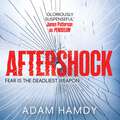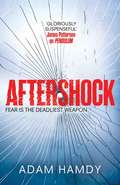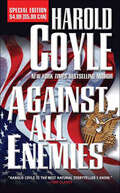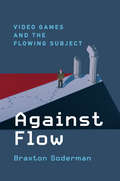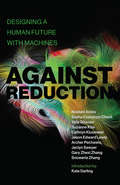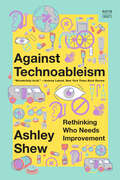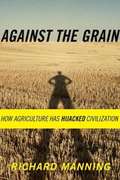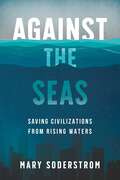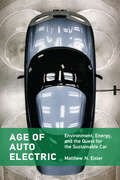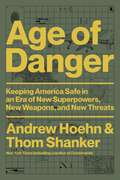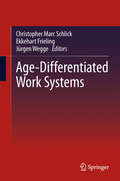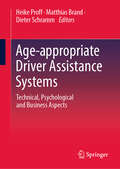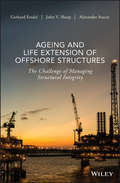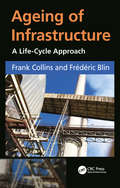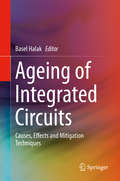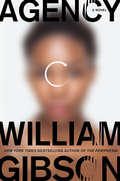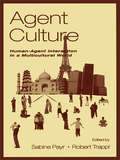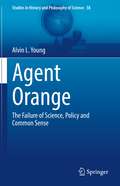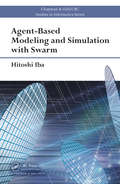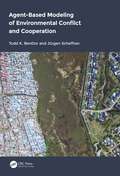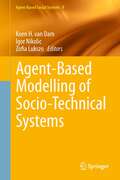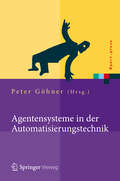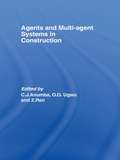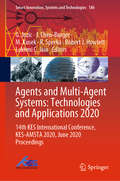- Table View
- List View
Aftershock: (Pendulum Series 3) (Pendulum #3)
by Adam HamdyTHE END IS NEAR.Adam Hamdy's first PENDULUM novel was called 'one of the best thrillers of the year' by James Patterson and a BBC Radio 2 Book Club pick. AFTERSHOCK is the page-turning climax to an explosive series that has gripped fans of Lee Child and Simon Kernick. THEY BELIEVED IT WAS OVERHaving survived the lethal Pendulum conspiracy, photographer John Wallace atones for his past mistakes.DI Patrick Bailey clings to the hope that he can, at last, return to a normal life in London. BUT IT'S ONLY JUST BEGINNINGFBI investigator Christine Ash - alone and paranoid - hunts down the remaining members of the ruthless Foundation organisation.DARK FORCES ARE RISING AGAINBut when masked assassins strike at the heart of the UK government, a shocking new threat emerges that forces all three to reunite.DEADLIER THAN EVER BEFOREWith time running out, they must defeat a lethal new adversary: a manipulative mastermind with sinister powers unlike anything they've seen before. 'Watch out, Jack Reacher and Alex Cross, the new generation is here!' - Crime Time(P)2018 Headline Publishing Group Ltd
Aftershock: (Pendulum Series 3) (Pendulum Series #3)
by Adam HamdyFEAR IS THE DEADLIEST WEAPON.Adam Hamdy's first PENDULUM novel was called 'one of the best thrillers of the year' by James Pattersonand chosen as a BBC Radio 2 Book Club pick. AFTERSHOCK is the page-turning climax to an explosive series that has gripped fans of Lee Child and Simon Kernick.'One of the best thriller writers I've read in recent years, Adam's writing is slick and unputdownable' Jenny Blackhurst,#1 eBook bestselling author THEY BELIEVED IT WAS OVERHaving survived the lethal Pendulum conspiracy, photographer John Wallace atones for his past mistakes.DI Patrick Bailey clings to the hope that he can, at last, return to a normal life in London. BUT IT'S ONLY JUST BEGINNINGFBI investigator Christine Ash - alone and paranoid - hunts down the remaining members of the ruthless Foundation organisation.DARK FORCES ARE RISING AGAINBut when masked assassins strike at the heart of the UK government, a shocking new threat emerges that forces all three to reunite.DEADLIER THAN EVER BEFOREWith time running out, they must defeat a lethal new adversary: a manipulative mastermind with sinister powers unlike anything they've seen before. 'Watch out, Jack Reacher and Alex Cross, the new generation is here!' - Crime TimeWhy readers are raving about AFTERSHOCK:'Cleverly plotted, excellent characters and a truly terrifying reality made Aftershock a truly gripping read.' *****Goodreads reviewer'Aftershock was hugely satisfying and an absolute pleasure. Could not have asked for more.Highly recommended.' *****Goodreads reviewer'A hard hitting action thriller in which the reader can never be sure who will survive or who will be turned...a recommended read' *****Goodreads reviewer Praise for the PENDULUM series:'I read Pendulum in one gloriously suspenseful weekend. Definitely one of the best thrillers of the year' James Patterson'So tense, you will be biting your nails long before the final chapter.' The Sun'A relentless, adrenaline-charged thriller that grips from the first page' Daily Express'One of the best thriller writers I've read in recent years, Adam's writing is slick and unputdownable, he hooks you in from the first chapter and doesn't let you come up for air.' Jenny Blackhurst,#1 eBook bestselling author
Against All Enemies (Nathan Dixon #2)
by Harold CoyleThe bestselling author of Team Yankee, "master of military fiction" Harold Coyle returns. In a novel both exciting and frighteningly realistic, Harold Coyle demonstrates once again that one of the nation's most important struggles is being fought on its own territory.Freedom. It is brought settlers to America's coasts, and it's the ideal that many laid down their lives to preserve. But, as the greatest nation in the world enters the new millennium, America finds itself once again split over the concept of liberty and justice for all.When one man decides to send a message to the government by bombing a federal building, the explosion is felt all across the country. The chain reaction that follows resonates most powerfully with members of a rebel band in Idaho who call themselves "Patriots" they want freedom from government control, no matter how much deadly force it takes. Their well-planned acts of terrorism soon show the government that they cannot be ignored and that definite action is needed.Thrown into the battle is Lieutenant Nathan Dixon, fresh from VMI, and a soldier who stands in the very large shadow of his father, the revered General Scott Dixon. Sent to quell a potentially dangerous situation, he'll need every bit of his training, for Nathan finds himself catapulted into the first battle of a new American war of secession.Covering the news is Nathan's stepmother, prominent anchorwoman Jan Fields. As the country watches, Jan discovers that Idaho's charismatic governor, George Oliver "GO" Thomas has an agenda of his own, one that may truly have a revolutionary effect on the whole country.Using the hard-edged style that made him famous, Harold Coyle takes us inside an all too plausible America where a nation is divided over the ideals on which this country was founded. In this modern military thriller, Coyle gives us an intimate portrait of the men and women who fight to uphold their, visions of America against all enemies. At the Publisher's request, this title is being sold without Digital Rights Management Software (DRM) applied.
Against Flow: Video Games and the Flowing Subject
by Braxton SodermanA critical discussion of the experience and theory of flow (as conceptualized by Mihaly Csikszentmihalyi) in video games.Flow--as conceptualized by the psychologist Mihaly Csikszentmihalyi--describes an experience of "being in the zone," of intense absorption in an activity. It is a central concept in the study of video games, although often applied somewhat uncritically. In Against Flow, Braxton Soderman takes a step back and offers a critical assessment of flow's historical, theoretical, political, and ideological contexts in relation to video games. With close readings of games that implement and represent flow, Soderman not only evaluates the concept of flow in terms of video games but also presents a general critique of flow and its sibling, play.
Against Reduction: Designing a Human Future with Machines
by Noelani Arista Sasha Costanza-Chock Vafa Ghazavi Suzanne KiteProvocative, hopeful essays imagine a future that is not reduced to algorithms.What is human flourishing in an age of machine intelligence, when many claim that the world&’s most complex problems can be reduced to narrow technical questions? Does more computing make us more intelligent, or simply more computationally powerful? We need not always resist reduction; our ability to simplify helps us interpret complicated situations. The trick is to know when and how to do so. Against Reduction offers a collection of provocative and illuminating essays that consider different ways of recognizing and addressing the reduction in our approach to artificial intelligence, and ultimately to ourselves.Inspired by a widely read manifesto by Joi Ito that called for embracing the diversity and irreducibility of the world, these essays offer persuasive and compelling variations on resisting reduction. Among other things, the writers draw on indigenous epistemology to argue for an extended &“circle of relationships&” that includes the nonhuman and robotic; cast &“Snow White&” as a tale of AI featuring a smart mirror; point out the cisnormativity of security protocol algorithms; map the interconnecting networks of so-called noncommunicable disease; and consider the limits of moral mathematics. Taken together, they show that we should push back against some of the reduction around us and do whatever is in our power to work toward broader solutions.
Against Technoableism: Rethinking Who Needs Improvement (A\norton Short Ser. #0)
by Ashley ShewOne of BookRiot’s Ten Best Disability Books of the Year Shortlisted for the Inc. Non-Obvious Book Awards “Wonderfully lucid.” —Andrew Leland, New York Times Book Review A manifesto exploding what we think we know about disability, and arguing that disabled people are the real experts when it comes to technology and disability. When bioethicist and professor Ashley Shew became a self-described “hard-of-hearing chemobrained amputee with Crohn’s disease and tinnitus,” there was no returning to “normal.” Suddenly well-meaning people called her an “inspiration” while grocery shopping or viewed her as a needy recipient of technological wizardry. Most disabled people don’t want what the abled assume they want—nor are they generally asked. Almost everyone will experience disability at some point in their lives, yet the abled persistently frame disability as an individual’s problem rather than a social one. In a warm, feisty voice and vibrant prose, Shew shows how we can create better narratives and more accessible futures by drawing from the insights of the cross-disability community. To forge a more equitable world, Shew argues that we must eliminate “technoableism”—the harmful belief that technology is a “solution” for disability; that the disabled simply await being “fixed” by technological wizardry; that making society more accessible and equitable is somehow a lesser priority. This badly needed introduction to disability expertise considers mobility devices, medical infrastructure, neurodivergence, and the crucial relationship between disability and race. The future, Shew points out, is surely disabled—whether through changing climate, new diseases, or even through space travel. It’s time we looked closely at how we all think about disability technologies and learn to envision disabilities not as liabilities, but as skill sets enabling all of us to navigate a challenging world.
Against the Grain: How Agriculture Has Hijacked Civilization
by Richard ManningIn this bold book, Richard Manning narrates a fascinating revisionist history of agriculture, from the domestication of plants and animals ten thousand years ago to today's corporate megafarms. Instead of a bucolic Ur-myth, Manning portrays an enterprise that was from its inception expansionist, and that did not so much accompany colonialism as drive it. Drawing on the work of anthropologists, biologists, archaeologists, and historians, as well as on his own extensive research, he traces a commodification of grain that has reached its apex in contemporary agribusiness and that has helped to build some of the most familiar -- and dysfunctional -- features of our political and economic landscape.
Against the Seas: Saving Civilizations from Rising Waters
by Mary SoderstromAn incredible read.… While unflinching in her analysis, Soderstrom nevertheless gifts us with a message of hope and resilience. — MAUDE BARLOW, activist and author of Still Hopeful: Lessons from a Lifetime of Activism. What can we learn about coping with rising sea levels from ancient times?The scenario we are facing is scary: within a few decades, sea levels around the world may well rise by a metre or more as glaciers and ice caps melt due to climate change. Large parts of our coastal cities will be flooded, the basic outline of our world will be changed, and torrential rains will present their own challenges. But this is not the first time that people have had to cope with threatening waters, because sea levels have been rising for thousands of years, ever since the end of the last Ice Age. Stories told by the Indigenous people in Australia and on the Pacific coast of North America, and those found in the Bible and the Epic of Gilgamesh, as well as Roman and Chinese histories all bear witness to just how traumatic these experiences were. The responses to these challenges varied: people adapted by building dikes, canals, and seawalls; by resorting to prayer or magic; and, very often, by moving out of the way of the rushing waters. Against the Seas explores these stories as well as the various measures being taken today to combat rising waters, focusing on five regions: Indonesia, Shanghai, the Sundarbans of Bangladesh, the Salish Sea, and the estuary of the St. Lawrence River. What happened in the past and what is being tried today may help us in the future and, if nothing else, give us hope that we will survive.
Age of Auto Electric: Environment, Energy, and the Quest for the Sustainable Car (Transformations: Studies in the History of Science and Technology)
by Matthew N. EislerThe electric vehicle revival reflects negotiations between public policy, which promotes clean, fuel-efficient vehicles, and the auto industry, which promotes high-performance vehicles.Electric cars were once as numerous as internal combustion engine cars before all but vanishing from American roads around World War I. Now, we are in the midst of an electric vehicle revival, and the goal for a sustainable car seems to be within reach. In Age of Auto Electric, Matthew N. Eisler shows that the halting development of the electric car in the intervening decades was a consequence of tensions between environmental, energy, and economic policy imperatives that informed a protracted reappraisal of the automobile system. These factors drove the electric vehicle revival, argues Eisler, hastening automaking&’s transformation into a science-based industry in the process.Challenging the common assumption that the electric vehicle revival is due to the development of better batteries, Age of Auto Electric instead focuses on changing environmental and socioeconomic conditions, energy and environmental policies, systems of energy conversion and industrial production, and innovation practices that affected the prevalence and popularity of electric vehicles in recent decades. Eisler describes a world in transition from legacy to alternative energy-conversion systems and the promises, compromises, new problems, and unintended consequences that enterprise has entailed.
Age of Danger: Keeping America Safe in an Era of New Superpowers, New Weapons, and New Threats
by Andrew Hoehn Thom ShankerAn urgent look at how America's national security machine went astray and how it fails to keep us safe—and what we can do to fix it. Again and again, American taxpayers are asked to open their wallets and pay for a national security machine that costs $1 trillion operate. Yet time and time again, the US government gets it wrong on critical issues. So what can be done? Enter bestselling author Thom Shanker and defense expert Andrew Hoehn. With decades of national security expertise between them and access to virtually every expert, they look at what&’s going wrong in national security and how to make it go right. Age of Danger looks at the major challenges facing America—from superpowers like Russia and China to emerging threats like pandemics, cybersecurity, climate change, and drones—and reimagines the national security apparatus into something that can truly keep Americans safe. Weaving together expert analysis with exclusive interviews from a new generation of national security leaders, Shanker and Hoehn argue that the United States must create an industrial-grade, life-saving machine out of a system that, for too long, was focused only on deterring adversaries and carrying out global military operations. It is a timely and crucial call to action—a call that if heeded, could save Americans lives, money, and our very future on the global stage.
Age-Differentiated Work Systems
by Christopher Marc Schlick Ekkehart Frieling Jürgen WeggeThe disproportionate aging of the population of working age in many nations around the world is a unique occurrence in the history of humankind. In the light of demographic change, it is becoming increasingly important to develop and use the potential of older employees. This edited volume Age-differentiated Work Systems provides a final report on a six-year priority program funded by the German Research Foundation (DFG) and presents selected research findings of 17 interdisciplinary project teams. The idea is that it will serve both as a reference book and overview of the current state of research in ergonomics, occupational psychology and related disciplines. It provides new models, methods, and procedures for analyzing and designing age-differentiated work systems with the aim of supporting subject matter experts from different areas in their decisions on labor and employment policies. Therefore over 40 laboratory experiments involving 2,000 participants and 50 field studies involving over 25,000 employees were conducted. Further objectives of the edited volume were to provide a pluridisciplinary compilation of the extensive information acquired over the six-year program period, to illustrate the range of the research field, and to convey an integrated understanding of age-differentiated work systems to readers.
Age-appropriate Driver Assistance Systems: Technical, Psychological and Business Aspects
by Dieter Schramm Heike Proff Matthias BrandPeople in highly developed countries are getting older and older. They want to be mobile in old age, but often have problems in road traffic. Even though they often pay a premium for age-appropriate products that increase safety, the demand for driver assistance systems among older drivers has so far been low. This book summarises the results of the ALFASY (ALtersgerechte FAhrerassistenzSYsteme) project, in which an acoustic driver assistance system is being developed and built to meet the needs of the steadily growing group of older drivers. Technical, psychological and economic aspects were investigated.
Ageing and Life Extension of Offshore Structures: The Challenge of Managing Structural Integrity
by Gerhard Ersdal John V. Sharp Alexander StaceyA comprehensive overview of managing and assessing safety and functionality of ageing offshore structures and pipelines A significant proportion, estimated at over 50%, of the worldwide infrastructure of offshore structures and pipelines is in a life extension phase and is vulnerable to ageing processes. This book captures the central elements of the management of ageing offshore structures and pipelines in the life extension phase. The book gives an overview of: the relevant ageing processes and hazards; how ageing processes are managed through the life cycle, including an overview of structural integrity management; how an engineer should go about assessing a structure that is to be operated beyond its original design life, and how ageing can be mitigated for safe and effective continued operation. Key Features: Provides an understanding of ageing processes and how these can be mitigated. Applies engineering methods to ensure that existing structures can be operated longer rather than decommissioned unduly prematurely. Helps engineers performing these tasks in both evaluating the existing structures and maintaining ageing structures in a safe manner. The book gives an updated summary of current practice and research on the topic of the management of ageing structures and pipelines in the life extension phase but also meets the needs of structural engineering students and practicing offshore and structural engineers in oil & gas and engineering companies. In addition, it should be of value to regulators of the offshore industry.
Ageing of Infrastructure: A Life-Cycle Approach
by Frank Collins Frédéric BlinThe book addresses the problem of ageing infrastructure and how ageing can reduce the service life below expected levels. The rate of ageing is affected by the type of construction material, environmental exposure, function of the infrastructure, and loading: each of these factors is considered in the assessment of ageing. How do international design codes address ageing? Predictive models of ageing behaviour are available and the different types (empirical, deterministic, and probabilistic) are discussed in a whole-of-life context. Life cycle plans, initiated at the design stage, can ensure that the design life is met, while optimising the management of the asset: reducing life cycle costs and reducing the environmental footprint due to less maintenance/remediation interventions and fewer unplanned stoppages and delays. Health monitoring of infrastructure can be conducted via implanted probes (wired or wireless) or by non-destructive testing that can routinely measure the durability, loading, and exposure environments at key locations around the facility. Routine monitoring can trigger preventative maintenance that can extend the life of the infrastructure and minimise unplanned and reactive remediation, while also providing ongoing data that can be utilised towards more durable future construction. Future infrastructure will need to be safe and durable, financially and environmentally sustainable over the lifecycle, thereby raising socio-economic wellbeing. The book concludes by discussing the key impacting factors that will need to be addressed. The author brings a strong academic and industry background to present a resource for academics and practitioners wishing to address the ageing of built infrastructure.
Ageing of Integrated Circuits: Causes, Effects and Mitigation Techniques
by Basel HalakThis book provides comprehensive coverage of the latest research into integrated circuits’ ageing, explaining the causes of this phenomenon, describing its effects on electronic systems, and providing mitigation techniques to build ageing-resilient circuits.
Agency: Public Agencies Under Fire (Urban Affairs Annual Reviews #15)
by William GibsonWilliam Gibson has trained his eye on the future for decades, ever since coining the term “cyberspace” and then popularizing it in his classic speculative novel Neuromancer in the early 1980s. Cory Doctorow raved that The Peripheral is “spectacular, a piece of trenchant, far-future speculation that features all the eyeball kicks of Neuromancer.” Now Gibson is back with Agency—a science fiction thriller heavily influenced by our most current events. <p><p> Verity Jane, gifted app whisperer, takes a job as the beta tester for a new product: a digital assistant, accessed through a pair of ordinary-looking glasses. “Eunice,” the disarmingly human AI in the glasses, manifests a face, a fragmentary past, and a canny grasp of combat strategy. Realizing that her cryptic new employers don’t yet know how powerful and valuable Eunice is, Verity instinctively decides that it’s best they don’t. <p> Meanwhile, a century ahead in London, in a different time line entirely, Wilf Netherton works amid plutocrats and plunderers, survivors of the slow and steady apocalypse known as the jackpot. His boss, the enigmatic Ainsley Lowbeer, can look into alternate pasts and nudge their ultimate directions. Verity and Eunice are her current project. Wilf can see what Verity and Eunice can’t: their own version of the jackpot, just around the corner, and the roles they both may play in it. <p> <b>A New York Times Bestseller</b>
Agent Culture: Human-agent interaction in A Multicultural World
by Robert Trappl Sabine PayrThis volume began with a workshop of the Austrian Research Institute for Artificial Intelligence held in 2001. Concerned with embodied agents as cultural objects and subjects, the book is divided into three parts. It begins by drawing attention to the cultural embeddedness of technology in general and agent design in particular, as a reminder that
Agent Orange: The Failure of Science, Policy and Common Sense (Studies in History and Philosophy of Science #58)
by Alvin L. YoungThis book tells the story of Agent Orange, its usage and the policies that surround it. Agent Orange contains a contaminant known as TCDD. It was the most widely used defoliant from 1965 – 1970 and became one of three major tactical herbicides used in Vietnam. More than 45 major health studies were conducted with Vietnam veterans from the United States, Australia, New Zealand, and Korea seeking a relationship between veterans’ health and TCDD. Allegations of birth defects in the families of Vietnam veterans and the Vietnamese represented a case study in propaganda and deliberate misinformation by the government of Vietnam. The Policies of the US Government implemented by Congress and the Department of Veterans Affairs (DVA) identified 17 recognized associated presumptive diseases that failed the tests of “cause and effect” and common sense. This book tells the story of Agent Orange, its usage, the health studies and those policies from a diverse range of perspectives, delving into science, statistics, history, policy and ethics. It is of interest to scholars engaged in history, political and social philosophy and ethics.
Agent and Multi-Agent Systems: 10th KES International Conference, KES-AMSTA 2016 Puerto de la Cruz, Tenerife, Spain, June 2016 Proceedings (Smart Innovation, Systems and Technologies #58)
by Lakhmi C. Jain Robert J. Howlett Gordan Jezic Yun-Heh Jessica Chen-BurgerThe modern economy is driven by technologies and knowledge. Digital technologies can free, shift and multiply choices, often intruding on the space of other industries, by providing new ways of conducting business operations and creating values for customers and companies. The topics covered in this volume include software agents, multi-agent systems, agent modelling, mobile and cloud computing, big data analysis, business intelligence, artificial intelligence, social systems, computer embedded systems and nature inspired manufacturing, etc. that contribute to the modern Digital Economy. This volume highlights new trends and challenges in agent, new digital and knowledge economy research and includes 28 papers classified in the following specific topics: business process management, agent-based modeling and simulation, anthropic-oriented computing, learning paradigms, business informatics and gaming, digital economy, and advances in networked virtual enterprises. Published papers were selected for presentation at the 10th KES Conference on Agent and Multi-Agent Systems: Technologies and Applications (KES-AMSTA 2016) held in Puerto de la Cruz, Tenerife, Spain. Presented results would be of theoretical and practical value to researchers and industrial practitioners working in the fields of artificial intelligence, collective computational intelligence, innovative business models, new digital and knowledge economy and, in particular, agent and multi-agent systems, technologies, tools and applications.
Agent-Based Modeling and Simulation with Swarm (Chapman & Hall/CRC Studies in Informatics Series)
by Hitoshi IbaSwarm-based multi-agent simulation leads to better modeling of tasks in biology, engineering, economics, art, and many other areas. It also facilitates an understanding of complicated phenomena that cannot be solved analytically. Agent-Based Modeling and Simulation with Swarm provides the methodology for a multi-agent-based modeling approach that i
Agent-Based Modeling of Environmental Conflict and Cooperation
by Jürgen Scheffran Todd BenDorConflict is a major facet of many environmental challenges of our time. However, growing conflict complexity makes it more difficult to identify win-win strategies for sustainable conflict resolution. Innovative methods are needed to help predict, understand, and resolve conflicts in cooperative ways.Agent-Based Modeling of Environmental Conflict and Cooperation examines computer modeling techniques as an important set of tools for assessing environmental and resource-based conflicts and, ultimately, for finding pathways to conflict resolution and cooperation. This book has two major goals. First, it argues that complexity science can be a unifying framework for professions engaged in conflict studies and resolution, including anthropology, law, management, peace studies, urban planning, and geography. Second, this book presents an innovative framework for approaching conflicts as complex adaptive systems by using many forms of environmental analysis, including system dynamics modeling, agent-based modeling, evolutionary game theory, viability theory, and network analysis. Known as VIABLE (Values and Investments from Agent-Based interaction and Learning in Environmental systems), this framework allows users to model advanced facets of conflicts—including institution building, coalition formation, adaptive learning, and the potential for future conflict—and conflict resolution based on the long-term viability of the actors’ strategies.Written for scholars, students, practitioners, and policy makers alike, this book offers readers an extensive introduction to environmental conflict research and resolution techniques. As the result of decades of research, the text presents a strong argument for conflict modeling and reviews the most popular and advanced techniques, including system dynamics modeling, agent-based modeling, and participatory modeling methods. This indispensable guide uses NetLogo, a widely used and free modeling software package, to implement the VIABLE modeling approach in three case study applications around the world. Readers are invited to explore, adapt, modify, and expand these models to conflicts they hope to better understand and resolve.
Agent-Based Modelling of Socio-Technical Systems (Agent-Based Social Systems #9)
by Zofia Lukszo Koen H. Dam Igor NikolicDecision makers in large scale interconnected network systems require simulation models for decision support. The behaviour of these systems is determined by many actors, situated in a dynamic, multi-actor, multi-objective and multi-level environment. How can such systems be modelled and how can the socio-technical complexity be captured? Agent-based modelling is a proven approach to handle this challenge. This book provides a practical introduction to agent-based modelling of socio-technical systems, based on a methodology that has been developed at TU Delft and which has been deployed in a large number of case studies. The book consists of two parts: the first presents the background, theory and methodology as well as practical guidelines and procedures for building models. In the second part this theory is applied to a number of case studies, where for each model the development steps are presented extensively, preparing the reader for creating own models.
Agentensysteme in der Automatisierungstechnik (Xpert.press)
by Peter GöhnerBei modernen automatisierten Systemen gewinnen Anforderungen an die Flexibilität (z. B. Anpassungsfähigkeit, Skalierbarkeit und Integrationsfähigkeit) zunehmend an Bedeutung. Vielfach ist jedoch noch unklar, wie die gewünschte Flexibilität bei der Entwicklung eines automatisierten Systems erzielt und die dadurch entstehenden komplexen Abläufe und Verhaltensweisen beherrscht werden können. Mit Hilfe von Softwareagenten wird es möglich, die notwendige Flexibilität von automatisierten Systemen systematisch zu entwerfen. Im GMA-Fachausschuss 5.15 "Agentensysteme" erarbeiten Fachleute aus Wissenschaft und Industrie Richtlinien zur Entwicklung und Anwendung von Agentensystemen in der Automatisierungstechnik. Im Rahmen dieser Arbeiten sind viele Beiträge zum Stand der Technik bzw. Stand der Wissenschaft von Agentensystemen in der Automatisierungstechnik entstanden, die in diesem Werk zusammengestellt wurden.
Agents and Multi-Agent Systems in Construction
by C. J. Anumba O. O. Ugwu Z. RenThis book describes current advances and future directions in the theory and application of intelligent agents and multi-agent systems in the Architecture, Engineering and Construction (AEC) sector. It is the product of an international effort involving a network of construction IT and computing researchers, investigating different aspects of agent theory and applications. The contributed chapters cover different perspectives and application areas, and represent significant efforts to harness emerging technologies such as intelligent agents and multi-agent systems for improved business processes in the AEC sector. The first four chapters cover the theoretical foundations of agent technology whilst the remaining chapters deal with the application of agent-based systems in solving problems in the construction domain.
Agents and Multi-Agent Systems: 14th KES International Conference, KES-AMSTA 2020, June 2020 Proceedings (Smart Innovation, Systems and Technologies #186)
by Lakhmi C. Jain Robert J. Howlett G. Jezic J. Chen-Burger M. Kusek R. SperkaThe book highlights new trends and challenges in research on agents and the new digital and knowledge economy. It includes papers on business process management, agent-based modeling and simulation and anthropic-oriented computing that were originally presented at the 14th International KES Conference on Agents and Multi-Agent Systems: Technologies and Applications (KES-AMSTA 2020), being held as a Virtual Conference in June 17–19, 2020. The respective papers cover topics such as software agents, multi-agent systems, agent modeling, mobile and cloud computing, big data analysis, business intelligence, artificial intelligence, social systems, computer embedded systems and nature inspired manufacturing, all of which contribute to the modern digital economy.
